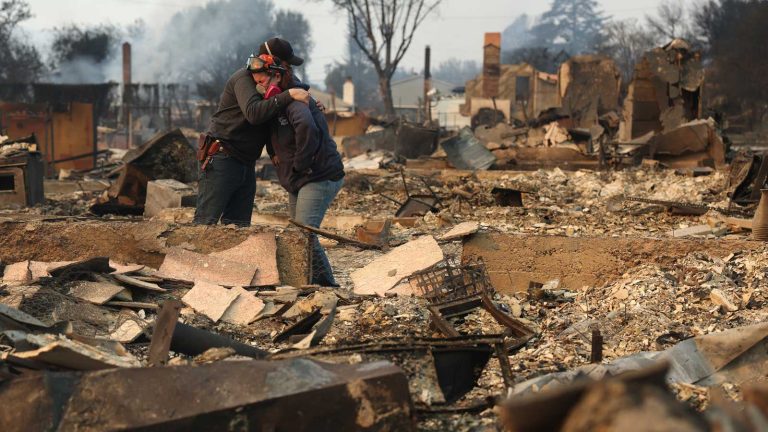Wildfires affecting the Los Angeles area have attracted state and national attention due to their rapid spread and severity due to extreme weather conditions and a prolonged drought. Amid the crisis, President-elect Donald Trump accused California Governor Gavin Newsom of mismanaging the fires.
Trump called Newsom “incompetent” in a post on the social media platform “Truth Social” and accused him of blocking water supplies in the southern part of the state to protect endangered fish.
“Governor Gavin Newscum refuses to sign a water restoration declaration put before him that would allow millions of gallons of water (from excess rain and snowmelt from the north) to flow daily into many areas of California, Including areas that are currently burning in an almost apocalyptic manner,” Trump wrote.
Newsom's office pushed back. “No such document exists and it is pure fiction,” Newsom's communications director Izzy Gardon said in a written statement. “The governor is focused on protecting people, not playing politics, And make sure firefighters have all the resources they need.”
Sacramento-San Joaquin Delta: A vital water source, but not a solution to wildfires
The Sacramento-San Joaquin Delta is an important water supply center in California. This vast network of wetlands and waterways connects the Sacramento and San Joaquin rivers to the San Francisco Bay, carrying water from the north to the south of the state. It is vital for agriculture, urban consumption and the protection of fragile ecosystems.
Delta management has been a contentious issue, particularly with regard to the conservation of the delta smelt, a small endemic fish whose numbers have declined so dramatically that it has been placed on the endangered species list. Its plight highlights the challenge of balancing human needs with environmental protection.
Trump suggested that water from the Sacramento-San Joaquin Delta in northern California could be used to fight wildfires in Los Angeles. However, most of the city's water does not come from this area. Los Angeles relies primarily on the Los Angeles Aqueduct, built in 1913, which carries water from the Owens Valley east of the Sierra Nevada Mountains.
Los Angeles wildfires: A climate-driven phenomenon
Caitlin Trudeau, senior climate science researcher at Climate Central, told Yale Climate Connection that the Los Angeles wildfires were caused by extreme weather.
“California's recent wildfires are a combination of natural and man-made factors,” Trudeau said in an email. Long-term droughts exacerbated by climate change have left vegetation dry and highly flammable.
These conditions are exacerbated by climate change, creating an environment where fires spread quickly and unpredictably.
California has seen a significant increase in wildfires in recent decades, a trend that experts attribute to climate change. Between 1971 and 1995, the average annual burned area was 361 square kilometers. Since 1996, this number has increased fivefold every year to 1,710 square kilometres.
Average temperatures in California have risen by about 1.5°C since the Industrial Revolution, when people began producing large amounts of heat-trapping pollution, primarily by burning fossil fuels.
Trudeau highlighted the role of Southern California's unique Santa Ana winds in exacerbating wildfires.
“Strong winds can fan the flames and start new fires,” she explained.
Severe Santa Ana winds sparked fires in the Los Angeles area this week. On Wednesday, January 8, at least 32 weather stations recorded wind gusts in excess of 70 mph (112 km/h), with peak gusts reaching about 20 miles north of the Mt. Lukens Truck Trail. 100 mph (161 km/h).
Mark Gold, director of water scarcity at the Natural Resources Defense Council and a board member of the Metropolitan Water District of Southern California, called it irresponsible to link management of the Bay Delta region to devastating wildfires. He said the Metropolitan Water District currently has the largest water storage capacity in history. He added that the real cause of the fires was not a lack of water in the north, but the continuing devastating effects of climate change.
Climate change as a catalyst
“Climate change is significantly exacerbating the conditions that trigger wildfires and increasing the frequency of fire weather in California,” Trudeau said.
Warmer temperatures can dry out soil and vegetation, leaving more fuel for fires, she explained. She also pointed out that intense heat waves not only dry out vegetation, but also weaken the resistance of trees, making them vulnerable to diseases and pests.
Additionally, a warmer spring and delayed fall have extended periods of high risk for wildfires, resulting in nearly year-round fire season in some areas.
What does the future require?
Amid political criticism of the country's management, Trudeau and other experts have stressed the need to address the root causes of wildfires through concrete measures.
“Effective land management is critical to reducing wildfire risk,” she said, highlighting practices such as controlled burning that can limit available fuels and reduce fire intensity.
However, she warned that these burns require specific weather conditions – “basically the opposite of fire weather” – making them difficult to implement amid the growing impacts of climate change. Trudeau said the scale of California's problem, with millions of acres of land to be treated, requires long-term commitment and effective coordination.
She also stressed the importance of a comprehensive approach to protecting vulnerable communities, including clear evacuation plans, multilingual alert systems and equitable access to resources such as education programs, housing improvements and mental health services.
“But I think it's important that we also note that when we can no longer use past experience to guide us, it becomes increasingly difficult to prepare for the future,” she said. “To slow down the rate of change we face, the best thing we can do is reduce carbon emissions as much and as quickly as possible.”
Only 28% of U.S. residents regularly hear about climate change in the media, but 77% want to know more. By 2025, you can show Americans more climate news.
